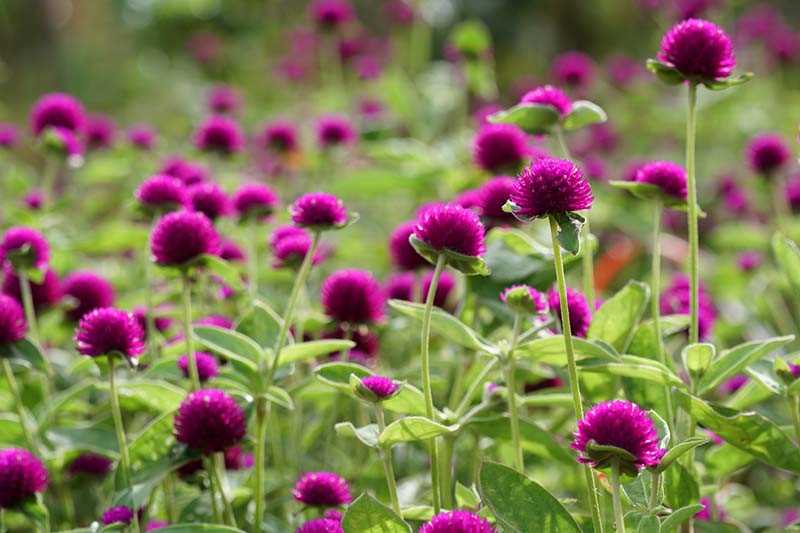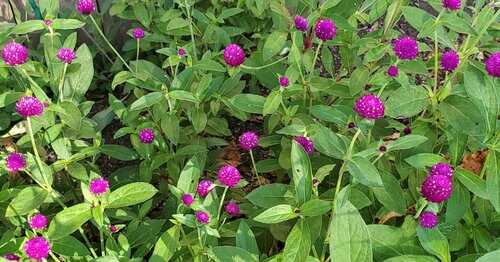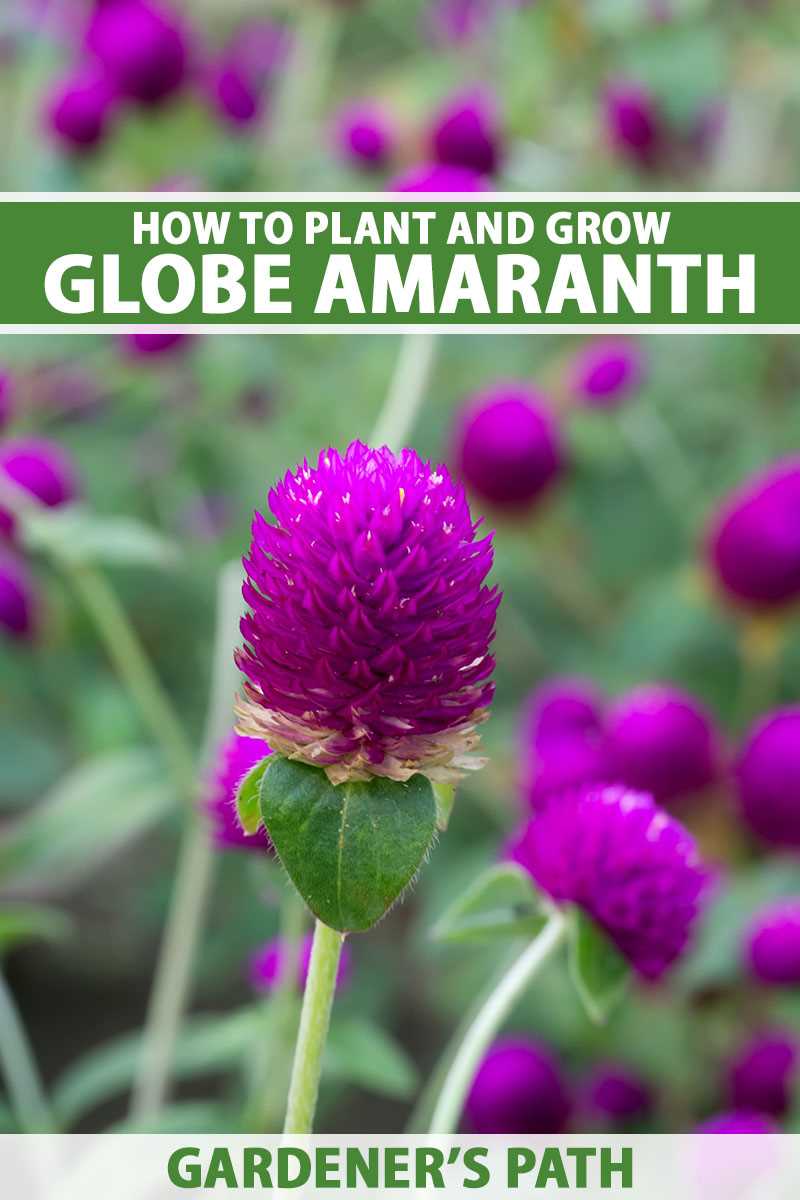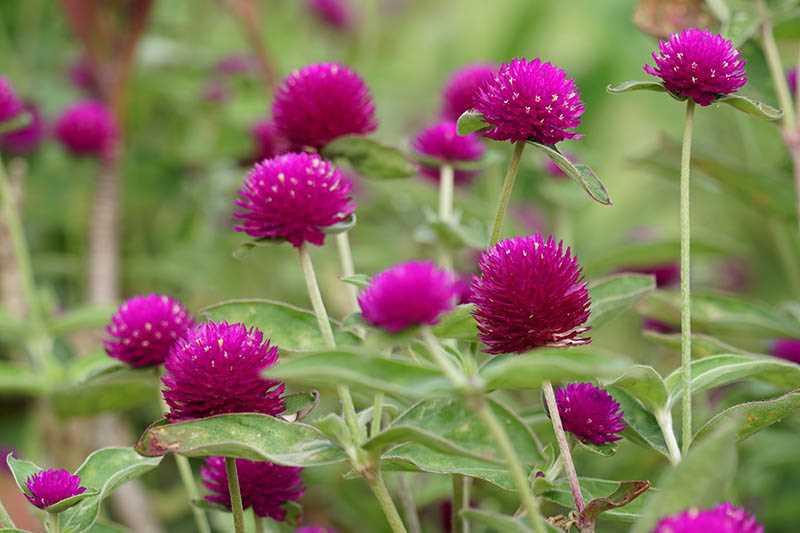- Cultivation of Gomphrena
- Soil Requirements:
- Sowing Gomphrena Seeds:
- Transplanting Gomphrena Seedlings:
- Watering:
- Fertilization:
- Pruning:
- Pest and Disease Control:
- Harvesting Gomphrena:
- How to care for Gomphrena plants
- Watering
- Light
- Soil
- Fertilizer
- Pruning
- Mulching
- Pests and Diseases
- Overwintering
- Types of Gomphrena
- 1. Gomphrena globosa
- 2. Gomphrena haageana
- 3. Gomphrena serrata
- 4. Gomphrena decumbens
- 5. Gomphrena pulchella
- 6. Gomphrena martiana
- Gomphrena globosa varieties
- Gomphrena haageana varieties
- 1. Strawberry Fields
- 2. QIS Formula Mix
- 3. Las Vegas Mix
- 4. Gnome Red
- 5. Buddy Purple
- Gomphrena serrata varieties
- 1. Buddy Purple
- 2. Buddy White
- 3. QIS Purple
- 4. QIS White
- Gomphrena Q&A: common questions and answers
- 1. How to grow Gomphrena?
- 2. What are the care requirements for Gomphrena?
- 3. Are there different types of Gomphrena?
- 4. Can Gomphrena be grown in containers?
- 5. How do you propagate Gomphrena?
- 6. Do Gomphrena attract pollinators?
- 7. How long do Gomphrena flowers last?
- 8. Is Gomphrena a perennial or an annual?
- 9. Can Gomphrena be grown as a border plant?
- 10. How tall does Gomphrena grow?
- Questions and Answers:
- What is Gomphrena?
- How to cultivate Gomphrena?
- What care does Gomphrena require?
- What are the different types of Gomphrena?
- What are some popular varieties of Gomphrena?
- Videos: How To Grow And Care For Gomphrena Flowers

Gomphrena, also known as globe amaranth, is a beautiful and versatile flowering plant that is popular among gardeners for its vibrant and long-lasting blooms. This hardy plant is native to Central and South America and is a member of the Amaranthaceae family. Gomphrena can be easily grown in gardens or containers, making it a perfect choice for both beginners and experienced gardeners.
Gomphrena plants are known for their unique, globe-shaped flowers that come in a variety of colors, including purple, pink, white, and red. These flowers are not only visually stunning but also attract pollinators like bees and butterflies to your garden. Gomphrena blooms from summer through fall, making it a great addition to any garden that needs a pop of color during those months.
When it comes to cultivation, gomphrena is a relatively low-maintenance plant that thrives in full sun and well-drained soil. It is drought-tolerant and can withstand hot and dry conditions, making it a great choice for gardens in arid regions. Gomphrena is also resistant to most pests and diseases, making it an easy-to-grow option for gardeners.
There are several types and varieties of gomphrena available, each with its own unique characteristics. Some popular varieties include Gomphrena globosa, Gomphrena haageana, and Gomphrena pulchella. These varieties vary in height, flower color, and growth habit, allowing you to choose the perfect gomphrena for your garden.
In this article, we will take an in-depth look at gomphrena cultivation, care, and the different types and varieties available. Whether you are a beginner or an experienced gardener, this comprehensive guide will provide you with all the information you need to successfully grow and enjoy gomphrena in your garden.
Cultivation of Gomphrena
Gomphrena is an easy-to-grow plant that thrives in warm, sunny environments. Here are some tips on how to cultivate Gomphrena successfully:
Soil Requirements:
- Gomphrena prefers well-drained soil that is fertile and rich in organic matter.
- Ensure the soil pH is between 6.0 and 7.0 for optimal growth.
Sowing Gomphrena Seeds:
- Start seeds indoors 6-8 weeks before the last frost date in your area.
- Sow the seeds onto the soil surface and lightly press them down. Do not cover them with soil, as they need light to germinate.
- Keep the soil consistently moist until germination occurs.
Transplanting Gomphrena Seedlings:
- After the last frost date, once the seedlings have developed their second set of true leaves, they can be transplanted outdoors.
- Choose a location with full sun exposure for optimal growth.
- Space the seedlings 12-18 inches apart to allow for proper air circulation and growth.
Watering:

- Gomphrena requires regular watering, especially during dry periods.
- Water at the base of the plant to minimize the risk of fungal diseases.
- Avoid overwatering, as Gomphrena prefers soil that is slightly dry rather than waterlogged.
Fertilization:
- Apply a balanced, slow-release fertilizer at the time of planting.
- Alternatively, you can top-dress the plants with compost or a balanced organic fertilizer during the growing season.
Pruning:
- Pinch back the tips of the plants when they are about 6 inches tall to encourage bushier growth.
- Remove any dead or faded flowers regularly to promote continuous blooming.
Pest and Disease Control:
- Gomphrena is relatively pest and disease resistant.
- However, keep an eye out for common garden pests such as aphids, snails, and slugs.
- If needed, treat the plants with appropriate organic pest control methods.
Harvesting Gomphrena:
- Gomphrena flowers are long-lasting and can be harvested for dried flower arrangements.
- When the flowers are fully open, cut the stems just above a leaf node.
- Hang the stems upside down in a dry, dark place to allow for drying.
By following these cultivation tips, you can enjoy the vibrant and long-lasting blooms of Gomphrena in your garden.
How to care for Gomphrena plants
Watering
Gomphrena plants need regular watering to thrive, especially during dry periods. It is important to keep the soil consistently moist, but not waterlogged. Avoid overwatering as it can lead to root rot. Water the plants deeply at the base and avoid wetting the leaves to prevent disease.
Light
Gomphrena plants require full sun to thrive. Choose a sunny spot in your garden where the plants can receive at least 6-8 hours of direct sunlight daily. Insufficient sunlight can lead to weak growth and fewer blooms.
Soil
Gomphrena plants prefer well-draining soil. The soil should be rich in organic matter with a pH level between 6.0 and 7.5. You can amend the soil with compost before planting to improve its fertility and drainage.
Fertilizer
Feed your Gomphrena plants with a balanced slow-release fertilizer once a month during the growing season. Alternatively, you can use a water-soluble fertilizer diluted to half strength every two weeks. This will help promote healthy growth and abundant blooms.
Pruning
To encourage bushier growth and more blooms, it is beneficial to pinch back the tips of the Gomphrena plants when they are young. This will help them branch out and produce more flowers. Additionally, remove any dead or faded flowers regularly to keep the plants looking tidy and to promote continuous blooming.
Mulching
Applying a layer of organic mulch around the base of the Gomphrena plants can help retain moisture, suppress weeds, and regulate soil temperature. Use materials such as straw, wood chips, or shredded leaves and apply the mulch to a thickness of 2-3 inches.
Pests and Diseases
Gomphrena plants are generally resistant to pests and diseases. However, they can still be susceptible to aphids, mealybugs, and fungal infections in humid conditions. Inspect the plants regularly for any signs of infestation or disease and take appropriate measures, such as using insecticidal soap or fungicides, to control the issues.
Overwintering
Gomphrena plants are usually grown as annuals in most regions. However, they can be overwintered in areas with mild winters. Before the first frost, cut back the plants to a few inches above the ground and mulch them heavily to protect the roots. In the spring, remove the mulch and new growth should emerge.
Types of Gomphrena
Gomphrena, also known as globe amaranth, comes in a variety of types and cultivars that offer a range of colors, sizes, and growth habits. Here are some popular types of Gomphrena:
1. Gomphrena globosa
Gomphrena globosa is the most common type of Gomphrena and is often referred to as the globe amaranth. It produces round, clover-like flower heads that come in a wide range of colors, including purple, pink, red, orange, and white. The flower heads are long-lasting and can be used in dried floral arrangements.
2. Gomphrena haageana
Gomphrena haageana, also known as Rio Grande globe amaranth, is another popular type of Gomphrena. It is native to Mexico and produces bright orange or yellow flowers. The flowers are smaller compared to Gomphrena globosa but are equally attractive.
3. Gomphrena serrata
Gomphrena serrata, commonly known as the toothed globe amaranth, is a type of Gomphrena that has toothed or serrated leaves. It produces small, round flower heads in shades of pink, purple, or white. This type of Gomphrena is often grown as an ornamental plant in garden beds or borders.
4. Gomphrena decumbens
Gomphrena decumbens, also known as prostrate globe amaranth, is a low-growing type of Gomphrena that forms a spreading mound of foliage. It produces small magenta flowers and is often used as a ground cover or in hanging baskets.
5. Gomphrena pulchella
Gomphrena pulchella, commonly known as the strawberry fields globe amaranth, is a compact type of Gomphrena that produces clusters of bright pink flowers that resemble strawberries. It is a popular choice for borders, containers, and mass plantings.
6. Gomphrena martiana
Gomphrena martiana, also known as petalody globe amaranth, is a unique type of Gomphrena that produces flower heads with modified petal-like structures. The flowers can be pink, purple, or white and add an interesting texture to floral arrangements.
These are just a few examples of the different types of Gomphrena available. Each type offers its own unique characteristics and can be grown in a variety of settings, from flower beds to containers. Consider incorporating Gomphrena into your garden to add a pop of color and interest.
Gomphrena globosa varieties
Gomphrena globosa, commonly known as globe amaranth, is a popular flowering plant with numerous varieties. These varieties differ in terms of flower color, size, and overall growth habit. Here are some of the most popular Gomphrena globosa varieties:
- Bicolor: This variety features bi-colored flowers, typically a combination of pink and white or purple and white.
- QIS Formula Mix: This variety is known for its vibrant and diverse flower colors, including shades of pink, purple, white, and red.
- Fireworks: With its unique fireworks-like flower shape, this variety adds a touch of whimsy to any garden. The flowers are usually a bright magenta color.
- Strawberry Fields: This variety produces large, round flowers in a deep, strawberry-like red color. It is a favorite among gardeners for its striking appearance.
- Audray Mix: Known for its compact growth habit, this variety is perfect for containers and small gardens. It offers a mix of colors, including pink, purple, and white.
These are just a few examples of the many Gomphrena globosa varieties available. Each variety has its own unique characteristics and can be grown in various garden settings. Whether you prefer bold and vibrant colors or more subtle hues, there is a Gomphrena globosa variety that will suit your preferences.
Gomphrena haageana varieties
Gomphrena haageana, commonly known as Mexican globe flower, is a species of flowering plant in the Amaranth family. It is native to Mexico and is cultivated for its beautiful flowers and long-lasting blooms. There are several popular varieties of Gomphrena haageana, each with its own unique characteristics:
1. Strawberry Fields
This variety is named for its striking bright red flowers that resemble strawberries. It has a compact growth habit and produces abundant blooms throughout the growing season.
2. QIS Formula Mix
This variety is a mix of different colors, including shades of pink, purple, white, and yellow. It is perfect for adding a pop of color to any garden or flower arrangement.
3. Las Vegas Mix
The Las Vegas Mix is known for its vibrant and eye-catching flowers in shades of red, orange, and yellow. It is a popular choice for adding a touch of tropical flair to landscapes.
4. Gnome Red
Gnome Red is a dwarf variety of Gomphrena haageana that grows to a height of only 4-6 inches. It produces small, round, deep red flowers and is ideal for edging or container planting.
5. Buddy Purple
Buddy Purple is a stunning variety with deep purple flowers that have a velvety texture. It is a vigorous grower and produces an abundance of blooms.
These are just a few examples of the many beautiful varieties of Gomphrena haageana available to gardeners. Whether you prefer bold and vibrant colors or more subtle shades, there is a Gomphrena haageana variety to suit your taste.
Gomphrena serrata varieties
Gomphrena serrata, commonly known as the globe amaranth or vadamalli, is a versatile and beautiful flowering plant. There are several varieties of Gomphrena serrata, each with its own unique features and characteristics. Here are some popular varieties:
1. Buddy Purple
- This variety of Gomphrena serrata produces vibrant purple flowers that are perfect for creating a striking contrast in your garden.
- Buddy Purple is known for its compact growth habit and can reach a height of about 12 inches.
- It is a long-flowering variety and will bloom throughout the summer, attracting butterflies and bees to your garden.
2. Buddy White
- As the name suggests, this variety of Gomphrena serrata produces beautiful white flowers that are sure to brighten up any garden.
- Buddy White is also a compact-growing variety, making it suitable for small gardens or containers.
- It is a hardy plant that can tolerate a wide range of soil and weather conditions.
3. QIS Purple
- This variety of Gomphrena serrata is known for its unique and eye-catching purple flowers.
- QIS Purple is a relatively taller variety, reaching a height of about 24 inches.
- It is a drought-tolerant variety and requires minimal maintenance.
4. QIS White
- QIS White is another popular variety of Gomphrena serrata that produces pure white flowers.
- It has a compact growth habit and can reach a height of about 12 inches.
- QIS White is a great choice for borders, containers, or as a filler in floral arrangements.
These are just a few examples of the many beautiful varieties of Gomphrena serrata available. Whether you prefer vibrant purple or elegant white flowers, there is a Gomphrena serrata variety to suit your taste and garden style.
Gomphrena Q&A: common questions and answers
1. How to grow Gomphrena?
Gomphrena can be grown from seeds or transplants. It prefers full sun and well-drained soil. Sow the seeds directly into the garden after the last frost date or start them indoors 6-8 weeks before the last frost. Transplants should be planted after the danger of frost has passed.
2. What are the care requirements for Gomphrena?
Gomphrena requires regular watering, especially during dry periods. However, it is tolerant of drought conditions. Deadheading the flowers will promote continuous blooming. Mulching around the plants can help conserve moisture and suppress weed growth.
3. Are there different types of Gomphrena?
Yes, there are different types of Gomphrena. Some of the common varieties include Gomphrena globosa (Globe Amaranth), Gomphrena haageana (Strawberry Fields), and Gomphrena pulchella (Fireworks). Each variety has its own unique characteristics and flower colors.
4. Can Gomphrena be grown in containers?
Yes, Gomphrena can be grown in containers. Choose a container that has good drainage and fill it with well-draining potting mix. Place the container in a location that receives full sun. Water the plant regularly and fertilize it according to the package instructions.
5. How do you propagate Gomphrena?
Gomphrena can be propagated by seeds or cuttings. To propagate by seeds, collect the seeds from mature flowers and sow them directly into the garden or start them indoors. To propagate by cuttings, take stem cuttings from a healthy plant, dip them in rooting hormone, and plant them in a well-draining potting mix.
6. Do Gomphrena attract pollinators?
Yes, Gomphrena flowers attract pollinators such as bees and butterflies. They are also known to attract beneficial insects like ladybugs and hoverflies, which help control garden pests.
7. How long do Gomphrena flowers last?
Gomphrena flowers are long-lasting and can stay on the plant for several weeks. They also make excellent cut flowers and can be dried for use in floral arrangements.
8. Is Gomphrena a perennial or an annual?

Gomphrena is usually grown as an annual, but it can be a perennial in warmer climates. In colder regions, it is recommended to treat Gomphrena as an annual and replant it each year.
9. Can Gomphrena be grown as a border plant?
Yes, Gomphrena can be grown as a border plant. Its compact growth habit and vibrant flowers make it an attractive choice for border plantings. It can also be used in mixed flower beds or as a container plant.
10. How tall does Gomphrena grow?

Gomphrena plants typically grow to a height of 12-24 inches (30-60 cm) and have a spread of 12-18 inches (30-45 cm). However, this may vary depending on the variety and growing conditions.
Questions and Answers:
What is Gomphrena?
Gomphrena is a genus of flowering plants in the family Amaranthaceae. It is commonly known as globe amaranth or bachelor’s button.
How to cultivate Gomphrena?
Gomphrena can be cultivated by sowing the seeds directly in the ground or in trays. The seeds should be covered lightly with soil and kept moist until germination. It prefers full sun and well-drained soil.
What care does Gomphrena require?
Gomphrena requires regular watering, especially during dry periods. It is a low-maintenance plant that doesn’t require much pruning or fertilization. However, it is important to remove faded flowers to encourage new blooms.
What are the different types of Gomphrena?
There are several types of Gomphrena, including Gomphrena globosa, Gomphrena haageana, and Gomphrena serrata. Each type has its own unique characteristics and flower colors.
What are some popular varieties of Gomphrena?
Some popular varieties of Gomphrena include ‘Strawberry Fields’, ‘Fireworks’, and ‘QIS Carmine’. These varieties are known for their vibrant flower colors and long-lasting blooms.







